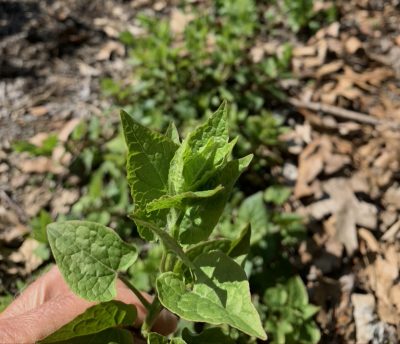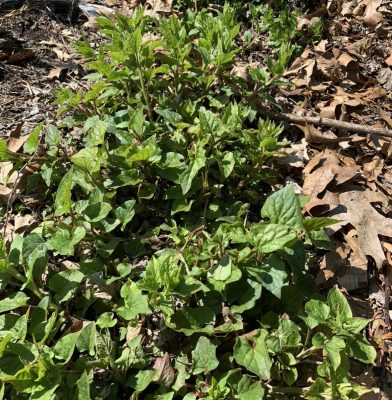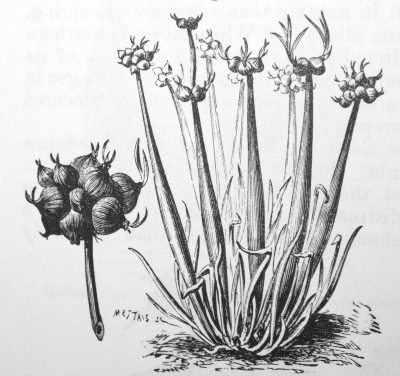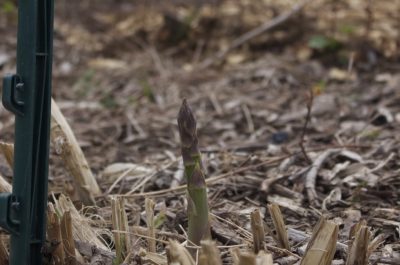PERENNIAL VEGETABLES
Hablitzia: What a Name!
At last night’s appropriately social distanced “zoom” dinner with my daughter, she commented on how tasty my salad looked. “All home grown,” I replied, and held up to the computer screen a leaf of one of the major contributors to my bowl of greenery, Caucasian mountain spinach (Hablitzia tamnoides). “Looks like some leaf you just plucked off a tree,” says she. Yes, it did, but it was as tasty and as tender as any leaf of regular garden spinach.

It’s with good reason that the two “spinaches” are so similar: They’re both in the same family, Amaranthacea, also kin to beets, chard, quinoa, lamb’s quarters, and pigweed.
Caucasian mountain spinach has it over conventional garden spinach in a number of ways, most significantly its being a perennial. I planted it last spring and don’t plan on doing so ever again. Not that making new plants would be difficult. They were easy from seed, and cuttings are also said to root easily. The quickest way to have larger new plants would be to divide the clump sometime after the tops have died back for winter or before new sprouts appear.
Being a perennial, Caucasian mountain spinach won’t lose quality as it goes to seed during the warmer, longer days of late spring and summer. White flowers, with a faint aroma of cilantro, appear in June and July, but the leaves still make tasty additions to salads or cooked dishes.
Right now, plants are starting to stretch their leafy stems skyward. Making use of the third dimension in gardening — up — makes for efficient use of garden space, a plus for any plant in an intensive garden. They’d like something on which to climb, which they do by pulling themselves upward in the same way as do clematis vines, twisting their leaf stalks around whatever they can. I’ll be providing a ladder for them made from posts and chicken wire.

Now that I think of it, Caucasian mountain spinach also makes use of the fourth dimension in gardening — time — since it can make its way into the kitchen from when my plum trees bloom until I harvest the last of my apples.
The Good King, and Others
The bed that’s home to Caucasian mountain spinach is also home to another perennial bit of edible greenery, Good King Henry (Blitum bonus-henricus), also sharing the Amaranthacea family. That bed gets some shade in the afternoon, which is all to the liking of Caucasian mountain spinach, not so much to Good King Henry.

No matter, because Good King Henry is not, in my opinion, nearly as tasty as its Caucasian cousin. The King’s leaves are good cooked, but not great, and not very good raw in salads. One reason I like it so much is for its name, both the common name and the botanical name.
I had hoped the bed would also be home to the perennial leek and perennial onion (Welsh onion) that I sowed and grew last season. But there’s not a sign of either plant this season. I guess they’re not all that perennial, odd since last winter was downright tropical (for here), the thermometer hardly dipping below zero degrees Fahrenheit.
If I wanted early onions, as greens, some kinds are reliably hardy. An interesting one that I grew decades ago is Egyptian Onion, also known as Walking Onion. They “walk” because the cluster of small bulbs atop the green stalks weight the stalks down till they eventually bow to the ground, depositing the cluster a few inches from the plant.  The bulbs take root, grow, bow, and deposit the bulbs another few inches away, so, unfettered, the plant spreads by “walking” around the garden. I stopped growing it because the flavor was too sharp for me.
The bulbs take root, grow, bow, and deposit the bulbs another few inches away, so, unfettered, the plant spreads by “walking” around the garden. I stopped growing it because the flavor was too sharp for me.
One More, This One Well-Known
One more perennial vegetable, this one familiar to everyone, is asparagus. I don’t understand why anyone who has a garden doesn’t grow asparagus. Even a flower garden, to which asparagus can offer a soft, green ferny backdrop. A bed offers two months of almost daily harvest. Rabbits and deer don’t eat it, so fencing isn’t needed (except in my garden, where my dogs have developed a taste for it).

And pests are rarely a problem. Except for weeds.
Perhaps you’ve been put off by the heroic measures for planting it suggested in older gardening books. That is, digging a deep trench, planting the roots in the bottom of the trench, and then gradually filling it in as the plants grow. Not necessary!
The deep planting suggested was to keep the plants’ crowns beyond the reach of tractors’ cultivator blades. But there’s no reason to cultivate an asparagus bed, and most home gardeners don’t anyway, so make holes just deep and wide enough to cover the roots when planting.
So there you have it, for easy gardening and tasty meals: Plant Caucasian mountain spinach and asparagus, and perhaps, especially if you like the name, Good King Henry.


About asparagus, I made the first time mistake of planting too deep. The too deep planing eventually died out. Planting shallow produces better plants and harvests in my experience. Japanese Beatles love the green, ferny foliage on my asparagus.But they are quite easy to spot and collect on asparagus.
Is this mountain Spinach also called Wild Spinach?
Will have to add Caucasian mountain spinach to our list of future plantings – have never heard of it, but we love our chard, spinach and other greens. We planted a raised bed of asparagus crowns this year and are already fascinated by the spears turning into beautiful, airy ferns. Just hope we can protect them through our harsh, windy winters on the mountainside.
Thank you for sharing your knowledge and experience – we have been enthralled with your blog since discovering it last night. The only downside – our plant and tree wish list has grown exponentially!
I have been doing a search on perennials for the food garden & found many plants that will fit in food & flower gardens, like true lillies. I am looking for tree collard cutting,crosne,wapato,giant solomon’s seal,yacon,oca,mashua & skirret.
I am sure there are nursery with these plants. Do you have one that you use?
No, no one nursery.
@joel LeGrand
Bill Whitson at Cultivariable breeds and sells most of those on your list
https://www.cultivariable.com/
Both Welsh onions and Egyptian onions are well-loved vegetables in our garden in southern Ontario. Welsh onions – a never-fail crop once established – are harvested in March, leaving a few behind to grow into next year’s cluster. The harvested onions are treated as green onions and grilled whole or used in stir-fries. I agree that Egyptian onion greens and stalks are too strong and coarse in flavor and are suitable only for the soup pot. But when the little bulbils appear in summer, they are wonderful when treated like shallots or pickled whole.
On your recommendation, I’m going to try Welsh onions again.
I am interested in the Caucasian Mountain Spinach, since it is perennial. Where can one get seeds around here (Kingston area)? (I have not done Internet searches yet.)
The spinach (Bloomsdale) seeded last fall is producing abundantly, and the arugula sown this spring is about ready to harvest.
Every year, I let a few arugula plants go to seed, and I have a lifetime supply by now. I keep it in the fridge, and it is viable up to 5 years. (And I am 78 years old.)
Today is the day to take down my hoop house that is overflowing with over-wintering lettuce and my new plants, like tomato, pepper and cabbage. I hope the last frost has passed.
Thanks for your informative blog.
You’ll probably find seeds of Caucasian mountain spinach only on the web. Mine are from Fedco and Experimental Seed Network.
Thanks! They are in the mail … WCM
Question: you mentioned that the flowers of Hablitzia have a faint aroma of cilantro, do the leaves have any trace of the flavor of cilantro? Cilantro is for me one of the most disgusting flavors and even the slightest trace of it is enough to completely spoil a dish for me. The aroma too makes me sick; which makes my efforts to grow a patch every season for my wife all the more heroic.
My plants are young, slated to flower this year. I’ll find out.
The possible Cilantro connection is interesting: A certain percentage of people (luckily, a minority) is genetically repulsed by Cilantro. I am among those. To me Cilantro tastes like a squashed stink bug smells, not at all pleasant.
I am planning to plant the spinach, as soon as the seeds arrive.
Hello, where is the spinach happiest? Full sun deep shade or somewhere in between? Thank you!
Full sun or, when weather becomes warmer, part shade. Definitely not full shade.
Here is a good source for perennial vegetables although they are sold our for 2020:
Edible Acres Nursery. They sell crosne and many other plants. Try the Sea Kale (crambe maritima) which is a perennial that resembles kale, tastes great and looks nice in the garden.
Has anyone tried the stems of Butterbur (petasites japonicum) known in Japan as Fuki? A Japanese friend tells me that she prepares them tempura style. The colony I have is trying to take over a shady corner of my garden.
I loved the idea of Hablitzia tamnoides but when I looked it up, it said growing zones 3-6. I am in 7A. Do you think I will have success?
Maybe not. But there are so many cool season vegetables that survive and grow in winter in your zone that you can be harvesting from your vegetable garden year ’round. Cabbage, kale, collards, turnips, radishes, arugula, mustard, chinese cabbages, carrots, etc.
Do you find this plant to be invasive? I looked it up and see it’s listed as one of the 100 most invasive plants in Europe. I’m intrigued, but don’t want to contribute to introducing another invasive.
Good point. But just think about all the free for the taking food for all.
Hello, Lee,
My husband and I are benefitting greatly from both your blog your Weedless Gardening book. We have been gardening for years, but have found Weedless Gardening to be so helpful. We are in the process of designing our drip system, per your recommendation :). Our garden is approximately 60′ X 35′ and we have a mix of longer and shorter beds as well as elderberries, raspberries etc, and some are raised. We are wondering if we can still use the 1/2″ mainline, 1/4″ dripper line in this size of a garden. We have good water flow, 414 GPH. No worries if you can’t comment, and thank you again for all the hard work of writing such helpful information!
1/2″ mainline can accommodate only 240 GPH water flow. Not that you’ll be using your total 414 GPH water flow from your water source. Figure out how many emitters you’ll have and multiply by water output per emitter to compute your water flow. If it’s more that 240 GPH, go with the 3/4″ tubing.
Thank you, Lee, we appreciate your help! I hope that wasn’t a time consuming question as you have enough on your plate.
Our best,
Pat and Walt
Hello Lee, I really enjoyed reading your article about perennial vegetables, I found it very helpful. Thank you, Richard
So helpful to have tasting notes on these plants. I’m reading some books on perennial vegetables but of course they mostly say all of them are great (based on this review I won’t bother with Good King Henry).